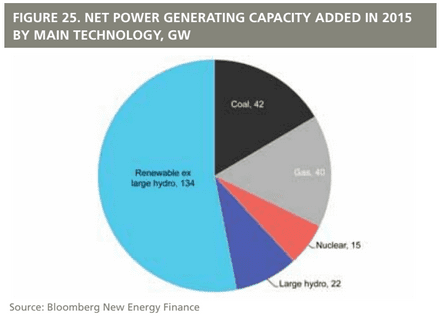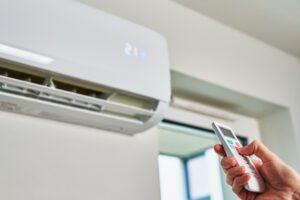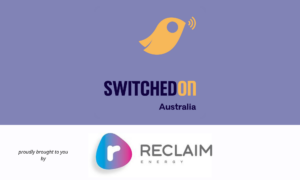A huge year for solar and wind energy pushed renewables to more than half of the new energy generation capacity installed in 2015, marking the first time ever that renewable energy – and that is without factoring in big hydro – has beaten out coal and gas-fired generation on this metric, even despite the plummeting prices of fossil fuels.
The ground-breaking renewables achievement was just one of many in the 2016 edition of UNEP’s Global Trends in Renewable Energy Investment, launched on Thursday by the Frankfurt School-UNEP Collaborating Centre for Climate & Sustainable Energy Finance and Bloomberg New Energy Finance (BNEF).
The report also found that 2015 produced a new record for global investment in renewable energy generation (excl. large hydro) capacity of $266 billion, and more than doubling the dollar allocations to coal and gas ($130 billion).
All investments in renewables, including early-stage technology and R&D as well as spending on new capacity, totalled $286 billion for the year, some 3 per cent higher than the previous record in 2011. Since 2004, the report says the world has invested $2.3 trillion in renewable energy.
Wind and solar were the standout technologies of the report, with a total of 118GW of new capacity added over the year, blitzing the next highest annual figure of 94GW in 2014.
Other honourable mentions go to the world’s developing nations, whose collective investment in renewables (excluding large hydro) outweighed that in developed economies – marking another first.
Countries including China, India and Brazil committed a total of $156 billion for the year, up 19 per cent on 2014 – China, alone, lifted its investment by 17 per cent to $102.9 billion, or 36 per cent of the world total.
The other developing nations to make up the top 10 were India, which saw its commitments rise 22 per cent to $10.2 billion, Brazil ($7.1 billion, down 10%), South Africa ($4.5 billion, up 329%), Mexico ($4 billion, up 105%) and Chile ($3.4 billion, up 151%).
All up, developed countries invested $130 billion in renewable generation capacity, charting a drop of 8 per cent on 2014 levels.
Australia, meanwhile, rates a mention in the list of “Notable countries that failed to make the top 10 in 2015 but had featured there in previous years” – a list that also includes Canada, France, Italy and Spain.
The report says that while renewables investment in Australia recovered a little in 2015, it remained at less than half of its peak levels, achieved back in 2011.
Interestingly, Australia also ranks as one of few developed economies in the report to have attracted $1 billion or more of investment in 2015, along with Japan and Canada. South Korea just missed out, with exactly $1 billion.
As you can see in the table below, Australia’s relatively small investment total in the “asset finance” category – $0.8bn (another $1.5 billion was invested in small-scale technologies) – amounts to a massive 239 per cent increase on 2014 numbers, when the RET was on ice and policy uncertainty brought investment to a standstill.
But Australia still shines in the category of small-scale solar, and in making mention of this, the report appears to contain a message for the country’s major political parties, as we head for a July election.
“Australia has one of the highest penetrations of residential rooftop PV globally – around 1.4 million systems have been installed, meaning one in six voters is now a stakeholder in the industry,” it says.
The year was also a big one for energy storage, with some 250MW of utility-scale electricity storage (excluding pumped hydro and lead-acid batteries) installed worldwide, up from 160MW in 2014.
The report notes that the trend for battery storage prices is “firmly downward”, and cites the example of Australia, where average residential system costs fell from $2,700 per kWh in October 2014 to $1,000 per kWh in November 2015 – a cost that typically includes inverters and balance of plant as well as the basic battery pack.
But despite notching up some “striking” numbers and exciting firsts, the report stresses that new clean energy technologies still only account for just over 10 per cent of world electricity generation, thanks to the “huge weight” of conventional capacity already built.
Likewise, the report adds, “the global emission trend remains worrying,” with energy-related emissions still on the rise and not forecast to peak until the late 2020s, at the earliest.









